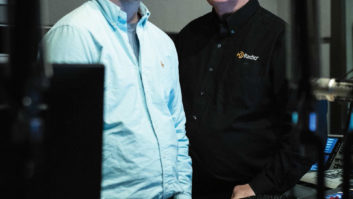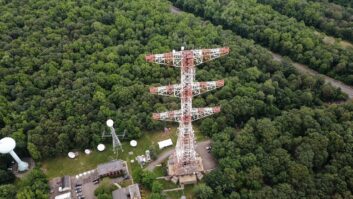There is something about tower lights …
As a youngster, traveling with my family through the Texas countryside, often at night, I would stare out the car window at those distant, glowing red orbs, flashing on and off, on and off, the waning glow persisting until the next on cycle. I often wondered what they were and how they could be seen from so great a distance.
Many years later, working the 4 p.m.-to-midnight air shift at the local FM station, the studio for which was collocated with the transmitter site, I would often step outside and look up that 800-foot angle-iron monstrosity and watch those pulsing lights, the underside of the crow’s nest at the top appearing and fading into blackness with each cycle.
On the wall in the back room there was a mysterious box with the name “Hughey & Phillips” cast into the cover, and that box made a strange, rhythmic, growling noise. Of course I couldn’t resist opening the latch for a look-see. Inside was a motor, a gearbox and some black bulbs with wires coming from them. I put two and two together and figured out that this was the mechanism that made the tower lights flash.
Then one day, something ugly happened up on the tower. The antenna and 700 feet of rigid transmission line burned up. Before we figured it out, a local tower crew went up the tower for a look, and of course I had to go with them.
That was a climb, let me tell you, but I was young and relatively fit, so I made it to the center of the antenna without issue.
On the way, I passed several platforms supporting beacons, and man, were those things huge! I’d had no idea that they were three feet tall and contained two huge light bulbs! How did they even get those things up there?
With the mystery of tower lights not so much a mystery anymore, as I moved from on-air to technical duties in the subsequent years, I didn’t give a whole lot of thought to tower lights until something went wrong. Then it was a matter of notifying the FAA and calling in a tower crew to deal with the issue. Occasionally I would have to deal with flasher issues, replacing a motor or mercury switch, maybe replacing a fuse, but that’s about it.
As the decades passed and technology advanced, those mercury switches became a thing of the past, replaced with solid-state flasher modules. I swapped out the innards of many a tower light controller box for solid-state SSAC flashers. Those devices were generally reliable, but they were not immune from lightning as the old mercury switches tended to be.

By the 1980s we began to see different kinds of lighting. The flashing red lights would go on/off instantly rather than waxing and waning as they always had before. Incandescent lamps were being replaced with lamps containing gas that would illuminate when excited by an electric current.
Then white strobes came along, often high-intensity day and medium-intensity at night, eliminating the need to paint towers altogether. In our company, we had just one strobed tower, 1,330 feet high, and it was a real pain and expense to keep it lit. Despite completely replacing the strobe system at one point, that tower was under a NOTAM more often than not.
[Visit Radio World’s News and Business Page]
Dual red/white night/day systems began appearing on some towers, particularly those in urban areas where flashing white lights in one’s bedroom window would be objectionable. We had one such tower in Chicago, and it, too, was a PITA to keep running.
And then along came LED technology. The combination of high-output LEDs and focusing mirrors made LED beacons a viable thing. Manufacturers began offering them as retrofit kits for incandescent-lit towers, using the 120 VAC coming up the tower light wiring to power retrofit LED beacons and marker lights.
We got on that bandwagon early and did not regret it. We figured out in a short time how much of our site electric bills went for tower lighting. AM sites with five or six towers, each with two 1,240-watt beacons plus four 110-watt markers, eat up a lot of power, more than the transmitter in a lot of cases. It was a very pleasant surprise to find our utility bills significantly lower.
Those early LED retrofits were not without their issues, though. Top beacons in particular would get eaten by lightning, and unlike the old incandescent lamps that would either ride through a strike without damage or require nothing more than a bulb replacement, the LED retrofits would require removal from the tower and often outright replacement (with internal power supply and LEDs damaged beyond economic repair). That often ate into the electric cost savings and made the cost/benefit equation harder to objectively solve.
In recent years, the FAA has made it easier to convert to dual red/white lighting for different heights of towers. Combine this with current LED technology, which is amazingly reliable, and the cost/benefit equation is an easy solve. In my company we have made the move to this model on a lot of towers. In most cases we’re in the black after the first paint job we didn’t have to do.
For a lot of broadcasters and other entities that use antenna structures, “rolling your own” by purchasing and installing an LED tower lighting system of any configuration is not an option. This is particularly the case for smaller broadcasters that may not have full-time technical personnel.
Those entities now have another option: tower lighting as a service. Yes, you heard it right. In the latest issue of RWEE, Tom Vernon tells us all about it. It may be just what the doctor ordered for a lot of broadcasters.
In the latest issue you will also hear from Buc Fitch, who provides us with another of his uber-practical DIY project articles, this time a composite demod that will come in handy for troubleshooting and even in the air chain. And Dennis Sloatman enlightens us with another of his great educational pieces, this time on the math and science behind microwave path budgets. You can read the issue here.
So sit back with your favorite beverage and read on. Let us know what you think. I’m at [email protected].







